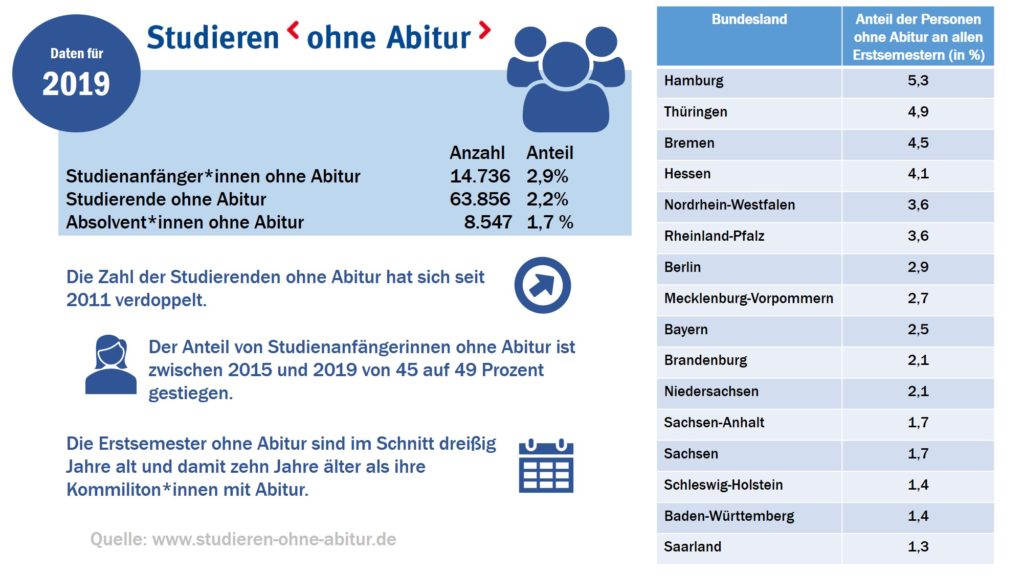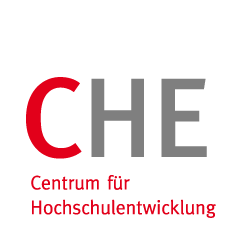 Foto: StockSnap / Pixabay
Foto: StockSnap / PixabayNever before have so many people in Germany made use of the opportunity to secure a place at university on the basis of their professional qualifications – the figure now stands at around 64,000 students. Among them are an increasing number of women. These figures were calculated recently by the CHE Centre for Higher Education. Hamburg, Thuringia and Bremen have the highest proportion of first-year students without a formal higher education entrance qualification. This group of students is ten years older on average than their counterparts who have Abitur.
A growing number of people are taking the “third route into higher education” in Germany. In the absence of a traditional university entrance qualification, these university entrants demonstrate having completed vocational training and professional experience instead. According to the latest data, around 64,000 non-traditional students were enrolled at German higher education institutions (HEIs) in 2019. This equates to an increase of 1,750 people compared to the previous year, accounting for 2.2 per cent of the entire student population.
However, the previous year’s records for new students and graduates without Abitur were narrowly missed in 2019. The number of first-year students is currently 14,700, which corresponds to 2.9 per cent of all new students. The number of graduates who entered higher education following vocational training and work experience now stands at 8,500, a figure that has almost doubled since 2013.
“The third route into higher education has established itself as an alternative to having a traditional university entrance qualification in Germany. As a result, higher education is accessible to many more people that was the case at the start of the 2000s,” explained Frank Ziegele. “In addition, the new record number of students without Abitur shows that the typical distinction between academic and vocational education is no longer valid for contemporary educational biographies,” commented the Executive Director of the CHE Centre for Higher Education.
However, the situation in the individual federal states continues to vary greatly. Hamburg is currently the state with the highest proportion of new students without Abitur as a percentage of all first-year students (5.3%), followed by Thuringia (4.9%) and Bremen (4.5%). Schleswig-Holstein and Baden-Württemberg (each with around 1.4%) and Saarland (1.3%) bring up the rear.
In contrast, a clear upward trend can be observed in Brandenburg and Thuringia, which improved their ranking among states by four and even seven places, respectively, compared to the previous year. “The main reason for the tremendous growth in Thuringia is the private IUBH International University of Applied Sciences, which moved its main site from North Rhine-Westphalia to Erfurt. As a result, its first-year student population now counts as being in Thuringia,” explained Sigrun Nickel, expert in the topic of “non-traditional applicants” at CHE.
The FernUniversität in Hagen continues to be Germany’s HEI with the largest number of first-year students without a formal higher education entrance qualification (1,400 enrolments). Of the ten most popular HEIs in Germany among students who do not have Abitur, eight are private and two are state-run. Even so, the majority of students without Abitur still attend state-run HEIs (41,000 enrolments). Private HEIs currently have around 21,500 non-traditional students, church-run universities have around 1,500.

Besides comparing federal states, CHE also analyses the composition of the student population with no formal higher education entrance qualification on an annual basis. “The average first-year student without Abitur is around 30 years old, and decides to pursue a Bachelor’s programme in the area of law, economics or social sciences at a university of applied sciences. Consequently, they are around ten years old than their counterparts with Abitur”, stated Sigrun Nickel, summarising the current analysis of data by CHE.
Another interesting finding is that women are increasingly going down this route. While the population of first-year students without Abitur was dominated by men in 2015, the proportion of female first-year students has now risen to around 49 per cent. There are clear differences in their choice of subjects. For example, women who hold a vocational qualification are much more likely to enrol in the subject group of medicine and health sciences, while men tend to pursue engineering degrees.
Now that the allocation of places to study medicine has been reformed, access opportunities for people without Abitur have improved. In this area, the number of students who qualified purely on the basis of their work experience almost doubled between 2014 and 2019, from 534 to 1,064. Of those, 850 study human medicine, and 214 study dentistry. The grade achieved in the master craftsman’s examination or Fachwirt examination is assessed in place of the Abitur grade in the application process for a place to study medicine.
Overall, two-thirds of all first-year students without Abitur opted to study at a university of applied sciences in 2019. 28 per cent chose a university, and four per cent joined an academy of art or music. A noteworthy development is the increasing tendency for such students to proceed to a Master’s programme after completing their Bachelor’s degree. In the 2019/20 academic year, around 12 per cent of all students without Abitur were pursuing a Master’s degree in Germany. In the 2015/16 academic year, the figure was only around seven per cent.
The general requirement for applying for a place at a university or a university of applied sciences without the traditional entrance qualification is a completed apprenticeship and proof of professional experience. The higher the level of qualification acquired by prospective students in their profession, the greater the choice of degree programmes open to them.
The online study guide:
The online study guide www.studieren-ohne-abitur.de provides detailed information, including the latest facts, figures and data concerning developments at the federal and state level. The guide is based on information provided by the Federal Statistical Office for the year 2019. The study guide enables prospective students who have no academic higher education entrance qualification to find out detailed information about admission options and the 8,000+ degree programmes offered at HEIs. The portal also contains lots of useful information and services such as a qualification and advisory check.
Länderberichte Studieren ohne Abitur 2019 25. März 2021 2.22 MB 21496 downloads
Die Situation in den Bundesländern auf einen Blick: Anteil Studienanfänger*innen,...Studieren ohne Abitur - Voraussetzungen für eine fachgebundene Hochschulzugangsberechtigung ohne Abitur in den einzelnen Bundesländern 14. März 2024 181.84 KB 34313 downloads
Nickel, Sigrun; Thiele, Anna-Lena: Studieren ohne Abitur - Voraussetzungen für eine...Studieren ohne Abitur - Voraussetzungen für eine allgemeine Hochschulzugangsberechtigung ohne Abitur in den einzelnen Bundesländern 14. März 2024 188.55 KB 32274 downloads
Nickel, Sigrun, Thiele, Anna-Lena: Studieren ohne Abitur - Voraussetzungen für eine...CHE kurz + kompakt: Studium ohne Abitur 14. März 2023 715.75 KB 156824 downloads
Nickel, Sigrun; Thiele, Anna-Lena: CHE kurz kompakt: Studium ohne Abitur, 2024, S....

